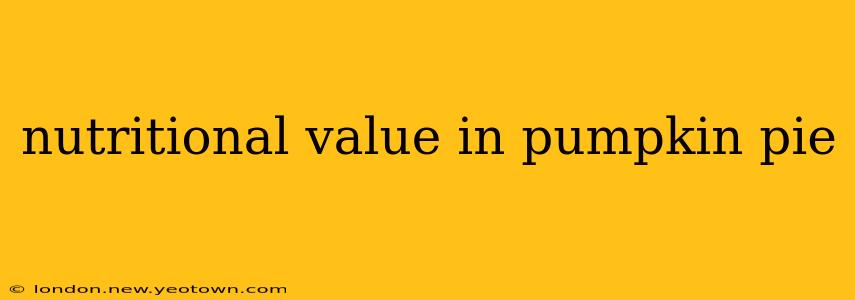A Slice of Autumn: Unveiling the Nutritional Value in Pumpkin Pie
The aroma of warm spices, the comforting sweetness, the delightful texture – pumpkin pie is the quintessential autumn dessert. But beyond its deliciousness, what’s the nutritional story behind this seasonal favorite? Let's delve into the nutritional value of pumpkin pie, exploring its benefits and drawbacks. This isn't about guilt-free indulgence, but rather a balanced understanding of what you're enjoying.
Imagine this: a crisp autumn evening, the leaves ablaze with color, and a warm slice of pumpkin pie gracing your plate. This isn't just a dessert; it's a small taste of the harvest, carrying with it a surprising array of nutrients, albeit in a concentrated, calorie-dense form.
What are the main nutrients in pumpkin pie?
The nutritional profile of pumpkin pie is largely determined by its key ingredients: pumpkin puree, spices, and the crust. Pumpkin puree itself is a nutritional powerhouse, packed with vitamin A, potassium, and fiber. However, the added sugar, fats from the crust (whether it's buttery pastry or a healthier alternative), and the creamy filling significantly alter its overall nutritional composition.
The good news? Pumpkin itself contributes valuable vitamins and minerals. It's rich in beta-carotene, a precursor to vitamin A, essential for vision, immune function, and cell growth. The potassium content supports healthy blood pressure, while the fiber aids digestion and promotes satiety. The spices, like cinnamon and nutmeg, add flavor and boast potential antioxidant properties.
But let's not ignore the less-than-stellar aspects. The sugar content in most pumpkin pie recipes is substantial, contributing to added calories and impacting blood sugar levels. The crust, typically made with refined flour and butter or shortening, adds significant amounts of saturated fat and calories.
Is pumpkin pie healthy?
The simple answer is: it depends. A homemade pumpkin pie made with less sugar and a whole-wheat crust will be nutritionally superior to a store-bought version laden with sugar and trans fats. Moderation is key. Enjoying a small slice as an occasional treat is unlikely to cause significant harm, especially if your overall diet is balanced. However, consuming large portions regularly can contribute to weight gain and other health issues.
How many calories are in a slice of pumpkin pie?
The calorie count varies significantly depending on the recipe and serving size. A standard slice of traditional pumpkin pie can easily pack in 300-400 calories, sometimes even more. The calorie count is significantly influenced by the crust and the amount of added sugar. Healthier versions, with reduced sugar and a whole-wheat or alternative crust, can have a slightly lower calorie count, but they'll still be a relatively high-calorie treat.
What are the health benefits of eating pumpkin pie (in moderation)?
Even with its caveats, a moderate serving of pumpkin pie can offer some health advantages:
- Vitamin A boost: Pumpkin puree is an excellent source of beta-carotene, which the body converts to vitamin A.
- Fiber content: Pumpkin contributes fiber, which aids digestion and promotes regularity.
- Antioxidant properties: The spices used in pumpkin pie, like cinnamon and nutmeg, possess antioxidant properties.
- Potassium: Pumpkin is a good source of potassium, important for maintaining healthy blood pressure.
Are there any downsides to eating pumpkin pie?
While delicious, overindulging in pumpkin pie can lead to several downsides:
- High calorie and sugar content: Excessive consumption can contribute to weight gain and increased blood sugar levels.
- High fat content: The crust, especially with traditional recipes, is high in saturated fat.
- Potential for digestive issues: Some individuals may experience digestive discomfort due to the high fat and sugar content.
What is a healthier way to enjoy pumpkin pie?
If you're mindful of your health, consider these tips for a healthier pumpkin pie experience:
- Make it yourself: This gives you complete control over the ingredients, allowing you to reduce sugar and use healthier alternatives for the crust.
- Reduce the sugar: Experiment with using less sugar in your recipe or incorporating natural sweeteners like maple syrup (in moderation).
- Choose a healthier crust: Opt for a whole-wheat crust, a crust made with alternative flours, or even a crustless version.
- Enjoy a smaller portion: Savor a smaller slice and pair it with a balanced meal.
Ultimately, enjoying pumpkin pie is about balance. A small slice, savored mindfully as part of a balanced diet, can be a delightful treat without significant negative health consequences. The key is awareness and moderation – allowing yourself to indulge in the flavors of autumn without compromising your overall well-being.

